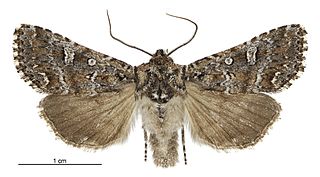
Ichneutica lithias is a moth of the family Noctuidae. This species is endemic to New Zealand. It is a small moth but distinctive as a result of the markings on its forewings. Although this species is widespread in the South Island, it has only been collected in the Rangipo Desert in the North Island. The species prefers habitat that is scrubland ranging in altitude from coastal to alpine. Adults are on the wing from October to April and larvae have been collected and reared on the New Zealand endemic plant species Melicytus alpinus.
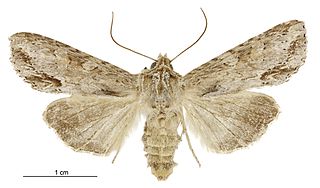
Ichneutica mollis is a moth of the family Noctuidae. It is endemic to New Zealand and is found from the Coromandel peninsular and Mount Te Aroha southwards including in the South and Stewart Islands. It lives in a variety of habitats including mountainous beech forest, podocarp forest and also grasslands. The larvae feed on grasses and herbs. The adults of this species are on the wing from October to March and are attracted to light and feed on blossoms.

Ichneutica morosa is a moth of the family Noctuidae. It is endemic to New Zealand and is found in the southern parts of the North Island and throughout the South Island. I. morosa is common in the eastern parts of both those islands and also in Fiordland. I. morosa can be found from altitudes ranging from lowlands to the alpine zone. I. morosa is absent from the range of its closely related species I. mustulenta, that is from the northern North Island. The larvae of I. morosa are known to feed on Poa astonii and also on other Poa species including introduced species. As well as its standard form the adult moths have a grey colour morph with the head and thorax being a grey and mottled brown, and the forewing being a pale greyish ochreous to a deep brown, suffused with grey. I. morosa can be confused with I. mustulenta and I. lignana. Adults are on the wing from November to April.

Ichneutica olivea is a moth of the family Noctuidae. It is endemic to New Zealand and is found in the central North Island down to the central South Island. It is very similar in appearance to I. lindsayorum but has a shorter basal streak and has white scaling from the subterminal line on the forewings that I. lindsayorum lacks This species prefers shrubland habitat. The life history of I. olivea is unknown as are the host species of its larvae. The adults are on the wing from December to March and are attracted to light.

Ichneutica omoplaca is a moth of the family Noctuidae. It is endemic to New Zealand. It is widespread from the Bay of Plenty in the North Island down to Southland in the South Island. Specimens have also been collected from the Auckland Islands. It lives in a variety of habitats including beech forest clearings and tussock grasslands. This species has been recorded that some of the larval hosts of this species include Poa cita, Dactylis glomerata and it has been reared on Plantago lanceolata. The larva is undescribed but pupae have been found in a pine plantation in soil under weeds. Adults of this species are on the wing from October to March. The adult moths are variable in appearance but the diagnostic feature is the pale ochreous to white colouring between the basal streak and the costa which contrasts with the ground colour of the forewing.

Ichneutica pelanodes is a moth of the family Noctuidae. It is endemic to New Zealand and has been found in scattered locations in the North, South and Stewart Islands. I. pelanodes is easily confused with I. skelloni as the two species are visually extremely similar. In the North Island though the range of the two species appears not to overlap. Generally of the two species I. pelanodes tends to be darker in appearance. I. pelanodes inhabits wetlands but the life history of this species is unknown as are the host species of its larvae. Adults are on the wing from October to February and are attracted both to sugar and light traps.

Ichneutica oliveri is a moth of the family Noctuidae. It is endemic to New Zealand, found only in the South Island. However it has not been observed on the eastern side of that island from mid-Canterbury southwards to Southland. This species is distinctive and is unlikely to be confused with other closely related species. It inhabits tussock grasslands, shrubland as well as granite sand plains, all in the alpine zone. Adults are on the wing from December to March and are attracted to light. They have been observed feeding on the flowers of Hebe species. The life history of this species is unknown as are the larval hosts.
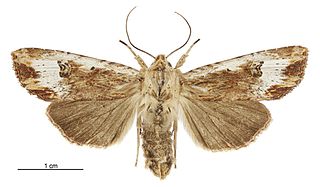
Ichneutica rubescens is a moth of the family Noctuidae. It is endemic to New Zealand. This species can be found locally in the North Island but is widespread throughout the South Island and is present on both Stewart Island and the Auckland Islands. I. rubescens has a round or oval mark near the centre of the forewing that encloses a dot. This is diagnostic of this species. I. rubescens inhabits tussock grasslands, beech as well as podocarp forests. Larval hosts are likely herbaceous plants such as grasses and herbs and larvae have been reared on Gunnera prorepens. Adults of this species are on the wing from December to April and are attracted to light.

Ichneutica scutata is a moth of the family Noctuidae. It is endemic to New Zealand. This species can be found in the southern parts of the North Island as well as the eastern parts of the South Island. It is similar in appearance to I. insignis and I. skelloni but can be distinguished as I. scutata is much paler in appearance. It is likely this species inhabits lowland tussock grasslands as well as coastal dunes although it is not common in inland tussock grasslands. The larvae feed on a variety of herbaceous plants such as Plantago and Convolvulus species, Plagianthus divaricatus. It pupates on soil near its host plants. The adults are on the wing from late March to July.
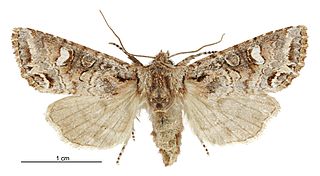
Ichneutica sericata is a moth of the family Noctuidae. It is endemic to New Zealand. This species is variable and difficult to distinguish from I. skelloni specimens. It is known from the southern part of the South Island and from Stewart Island. There has been one specimen collected in Taranaki but although Robert Hoare determined the species, he expressed reservations given the location of collection. I. sercata inhabits shrubland at altitudes of between 470 and 900m. The life history of this species is unknown as are the host species of its larvae. The adults of this species are on the wing in August at Stewart Island and in November and December in the South Island.
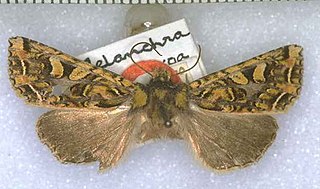
Meterana tetrachroa is a species of moth of the family Noctuidae. This species is endemic to New Zealand. It is classified as "Data Deficient" by the Department of Conservation.

Ichneutica averilla is a moth of the family Noctuidae. It is endemic to New Zealand. This species is found in the North Island at Mount Taranaki but is widespread throughout the South Island and Stewart Island. It prefers mountainous habitat but can be found down to sea level in the southern parts of the South Island. Adults of the species are on the wing between November and March. Larvae likely exist on a variety of herbaceous plants but have been recorded as feeding on species within the genus Plantago. This species is sometimes confused with I. mutas but can be distinguished from the latter on the basis of forewing colour as well as the absence of or an indistinct antemedian forewing line.

Ichneutica paraxysta is a moth of the family Noctuidae. It is endemic to New Zealand. This species is very similar in appearance to its close relative I. acontistis but as the range of the two species do not overlap this is unlikely to cause confusion. I. paraxysta is only found in the North Island at the subalpine zones in the Mount Taranaki region and at Mount Ruapehu. It prefers tussock grassland and shrubland habitat. The life history of this species is unknown as are the host species of its larvae however it has been hypothesised that the larval host plants are species in the genera of Poa and Festuca.
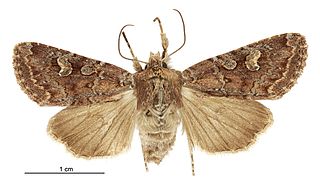
Ichneutica agorastis is a moth of the family Noctuidae. This species is endemic to New Zealand. This moth is similar in appearance to two other species in the genus but can be distinguished through the colour and size of its forewings. This species is found in the South Island and Stewart Island in open habitats in the subalpine zone. However, in Southland I. agorastis can be found down to sea-level. Adult moths are on the wing between January and April. The life history and host species are unknown.

Ichneutica panda is a species of moth in the family Noctuidae. It is endemic to New Zealand and only found in central and southern parts of the South Island. The species has not been collected in Canterbury since the late 1950s and has not been seen at The Wilderness scientific reserve since 1941. This species is similar in appearance to Ichneutica falsidica however I. panda lack or have indistinct black dashes on their edge of their hindwings. I. panda inhabit shrubland from alpine zones down to river terraces and adults are on the wing between December and February. The life history of this species is unknown as is the host species of the larvae.
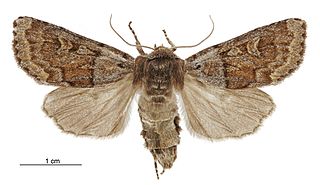
Ichneutica marmorata is a moth of the family Noctuidae. This species is endemic to New Zealand and can be found in the North Island at the Tongariro National Park and at Puketitiri near the Kaweka Range. In the South Island it is widespread. It prefers alpine to subalpine habitat but occurs down to sea level altitudes in more southern locations. Adults are on the wing from late October to February. Larvae of this species may use tussock grasses in the genus Chionochloa as their host and they have been reared on Festuca novae-zelandiae.

Ichneutica chlorodonta, also known as the Green-toothed Owlet, is a moth of the family Noctuidae. This species is endemic to New Zealand. It is found throughout the North, South and Stewart Islands and is associated with native forest and shrubland. It can be confused with similar looking species such as I. subcyprea however I. chlorodonta can be distinguished through differences in colouration of its fore and hind wings as well as the length of the male pectinations. The life history of this species is unknown as are the host species of its larvae but adults of I. chlorodonta are on the wing from September to April.
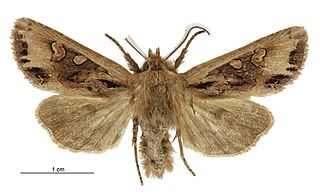
Ichneutica fenwicki is a moth of the family Noctuidae. This species is endemic to New Zealand and is found in the southern parts of the South Island and on Stewart Island. It is a distinctively coloured moth that is unlikely to be confused with closely related species. It is a spring flying moth being on the wing from September to November. The life history and host species of the larvae of I. fenwicki are unknown.
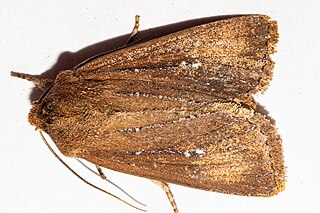
Ichneutica sapiens is a moth of the family Noctuidae. This species is endemic to New Zealand. I. sapiens is found in the central North Island, in the South Island in Westland and also the southern parts of the South Island, and in Stewart Island. This species inhabits wetland habitat but its life history is unknown as are the host species of its larvae. The adult moths are on the wing between December and early January and are attracted to sugar traps and to light. I. sapiens is very similar in appearance to I. micrastra but is a smaller moth with a shorter wingspan, has differently formed antennae and slightly different forewing markings.

Ichneutica paracausta is a moth of the family Noctuidae. This species is endemic to New Zealand. It is found locally in the central North Island, is widespread in the South Island and can also be found in Stewart Island. I. paracausta is variable in colour, but as it has a distinctive black streak on its forewing as well as a wing pattern that is characteristic, I. paracausta is unlikely to be confused with other species. It is present on the North Island volcanic plateau as well as Little Bush Reserve in Hawkes Bay in the North Island as well as in tussock grassland, alpine and subalpine shrubland and in alpine forest. Larvae have been recorded as feeding on grasses, a pupa has been found in a cocoon under the bark of a tree and adult moths are on the wing from October to January.





















